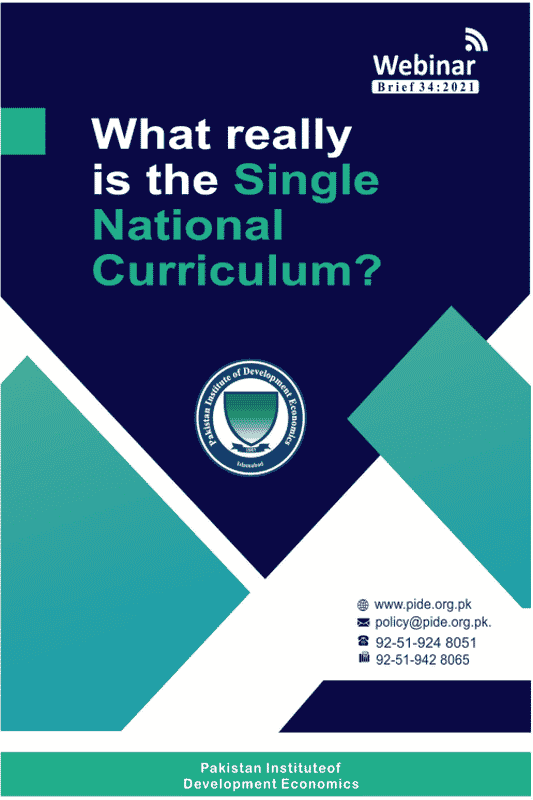
Pakistan Institute of Development Economics
- Home
Our Portals
MenuMenuMenuMenuMenuMenuMenu - ResearchMenuMenuMenuMenuMenuMenuMenu
- Discourse
- The PDR
- Our Researchers
- Academics
- Degree Verification
- Thesis Portal
- Our Portals
What Really Is The Single National Curriculum?
Publication Year : 2021
Author: Nafisa Riaz
Explore More : Webinars Brief
What really is the Single National Curriculum?
Preamble
This brief presents the key points from interactive discussion among the moderator and the panelist. This discussion provides a detailed account of the present government’s initiative of the single national curriculum and highlights its shortcomings.
Key Messages
- The notion of a single national curriculum arises from the gap between Curriculum and Standards of learning outcomes. Learning standards are designed universally and are mandatory for effective learning, whereas the Curriculum consists of all the learning experiences a child went through in the journey of the educational process. It includes infrastructure, textbooks, evaluation methods, co-curricular activities, and teaching techniques. At present, the government introduced minimum learning standards which is an up-gradation of the minimum standards of the 2006 curriculum.
- The curriculum needs to be revised frequently to meet the challenges of evolving needs of society. it is not a complete overhaul of the existing one. It may be upgraded partially. Few subjects like science or early childhood require more frequent up-gradation as new research emerges. In Pakistan, the last time curriculum was revised in 2011.
- In Pakistan, the organization of the National Curriculum Council (NCC) operating at the federal level is tasked to upgrade the curriculum frequently. The present version of modifications, introduced by the PTI government named as “Single National curriculum”, in the curriculum is primarily based on the manifesto of the PTI government which raised the issue of a Single national curriculum to eliminate the class conflictse. secular vs religious, private vs public differences in the education process. They presumed that it will result in a level playing field for all and will enhance social and economic mobility.
- The issue of a single national curriculum remained a debatable issue ever since as there is a massive skepticism about the nature of a curriculum formed under a unified body. After the 18th amendment, education is regarded as a provincial purview. The provincial textbook board must review and the province can reject the unified curriculum as the Sindh government did in the case of the present initiative by the government.
- The procedure of curriculum development was taken up by NCC in 2018 and a task force was formed comprising various stakeholders including members of various NGOs, school systems, and renowned people in the field. These people only gave their strategic viewpoint but the actual documentation was carved out by development practitioners. Various workgroups were formed comprising Provincial & Federal ministries, and educationists from private school systems. They reviewed already existing documents on the subject matter, used their research conducted in bubbles in different domains, and presented the single curriculum as a mixture of all findings.
- The facts based on international testing schemes like “Trends in InternationalMathematics and Science Study” (TIMSS) conducted in 2019 which test the learning outcomes of a student in 4th and 8th grade, suggests that among the low middle-income countries Pakistan ranked 2nd last where the Philippines was the worst-performing country in term of learning outcomes. In a science test, only 37% of students responded correctly to a question regarding living and non-living things. 27% of students met the lower benchmark in a math test score, 8% met the intermediate benchmark while only 1% of students met the high benchmark. Similarly, our local tests also offer the same results. It shows that merely changing learning standards is not sufficient. There are other factors like school environment, teaching and evaluation methods, socio-economic status, parent’s income level, etc. which also influence the learning of a child.
- The panelists expressed concerns regarding transparency of the process, suggesting that as it is a matter of public policy, therefore, it must be publically determined incorporating the feedback of primary stakeholders i.e. parents and teachers. Upon immense criticism, the government justified its version of the curriculum by giving the figures that it took 2 years and services of about 400 educationists to formulate the curriculum.
- Panelists also reviewed the new curriculum of a few subjects and concluded that the claims made by the government that the new curriculum replace the old rote memorization curriculum with critical thinking in the new one is wrong.
Dr. Nadeem ul Haque suggested an opportunistic approach for strengthening education as it would eliminate the unnecessary cost of monitoring in the education sector.
© 2024 Pakistan Institute of Development Economics



